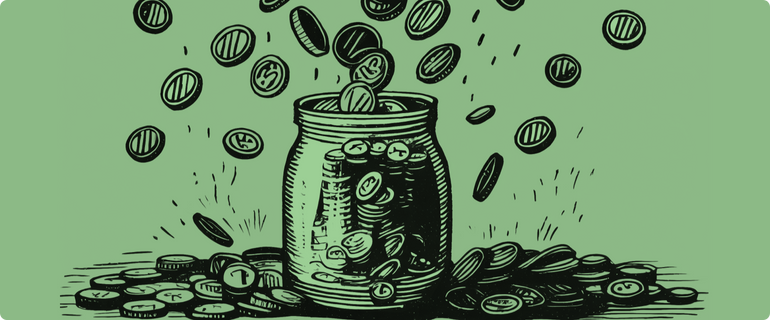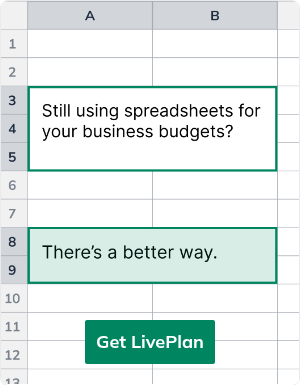5 Small Business Cash Flow Management Tips

Jump to
Look, not everyone gets excited about spreadsheets or accounting software. But as a business owner, understanding your cash flow — the money moving in and out of your business — is crucial for keeping your business healthy.
That’s because a profitable business can still unfortunately run out of cash and go under.
Think about it: Often, when a business makes a sale, it invoices the customer instead of taking payment upfront. In that case, the business records all of the revenue from the sale on its income statement as soon as the deal is made.
But they haven’t actually received the money yet. When calculating cash flow, money from a sale isn’t recorded until the customer has actually paid.
It’s an important distinction. That business likely has financial obligations of its own — rent, utilities, payroll, maybe monthly payments on a loan. If it can’t pay bills or workers on time, it won’t matter that it is owed enough money to cover those expenses.
At the end of the day, CASH IS KING, no matter what your profits look like.
The good news? You don’t have to be a financial wizard to keep things running smoothly. Here are five simple tips for improving your cash flow that anyone can follow. You can also read our detailed guide on managing cash to grow your business.
1. Keep personal and business money separate
Many small business owners co-mingle their personal and business accounts. Don’t.
Using your personal bank account for those initial business expenses or depositing that first check from a client right into your everyday checking seems simple enough, especially when a business owner is just starting out.
But it’ll cause major headaches at tax time, and make tracking expenses a nightmare.
Imagine having to meticulously sort through twelve months of bank statements, trying to separate every business lunch receipt, software subscription, or supply purchase from your personal bills and grocery trips.
Beyond taxes, co-mingling funds completely muddies the waters of a business’s financial health. How can anyone know if their business is generating positive cash flow if money is flowing in and out while mixed with personal expenses or other sources of cash like getting repaid on Venmo or PayPal for someone whose lunch bill you covered last week?
Establish a dedicated business account, and you’ll instantly feel more organized, with access to more detailed information about your business’s financial health. And if you ever need to apply for a loan or credit line, you’ll need to present clear financial records.
Learn More: How to Open a Business Bank Account
2. Know how much you need to stay open
Forget fancy calculations. Instead, take out a notepad or spreadsheet and just list every single non-negotiable expense that you must pay each month. They might include:
Rent or mortgage payments
Utilities (electricity, water, internet)
Payroll
Loan payments
Key software subscriptions
Insurance premiums
Inventory and supplies
Think of these as your business’s cost of living expenses, or your operational break-even point in terms of cash outflow. The total represents the minimum amount of cash your business needs each month just to cover its fundamental obligations. This doesn’t mean the business has to generate this much revenue. It just means that it needs the cash, whether that’s through sales to customers, selling assets, or getting a business loan.
(This is why a business’s cash flow statement is typically broken down into three categories: cash flow from operations, cash flow from investments, and cash flow from financing).
And remember, as I discussed earlier, a business doesn’t always get cash right after making a sale. If they’ve invoiced a customer for payment, their cash flow from operations doesn’t change until they get the money. And if that customer takes 30 or 60 days to pay, but rent or payroll is due sooner, you need the cash then, regardless of what your sales figures say.
Learn More: A Fast and Easy Way to Build an Expense Budget
3. Understand your cash flow assumptions and cash drivers
If you understand your monthly expenses, then you also need to understand the actual cash you’ll collect every month.
Put another way: You need a cash flow forecast.
Business owners create cash flow forecasts to predict how much money their business is going to need, and when they’re going to need it.
I’ve already mentioned that you can’t record revenue on your cash flow statement until you’ve received payment. But when will you receive it? And will you receive it all at once, or in installments? Also, how often do customers cancel orders, return them, or for any reason not pay? Cash flow assumptions are your best guesses about timing, and understanding these assumptions is vital for painting an accurate picture of your business’s cash position.
Cash drivers are the activities that most directly cause cash to flow in or out of a business. They typically include:
Accounts receivable: Money that a business is owed but hasn’t received yet.
Accounts payable: Money that a business owes to suppliers, lenders or investors, but hasn’t paid yet.
Inventory purchases: For businesses that sell products, buying inventory usually requires spending cash before making a sale. Over time, this affects both cash outflows (based on the time it takes the business to pay those suppliers) and cash inflows (when it eventually sells those supplies and receives payment).
A cash flow forecast combines cash inflows — based on those assumptions about when payment will be received — and outflows to map out a business’s projected cash position over time.
By taking the time to create a forecast, business owners create an early warning system for themselves, revealing when future cash crunches might occur. It gives them time to consider options like pushing harder to collect unpaid invoices or negotiating longer payment terms with a supplier.
4. Build up cash reserves with a rainy day fund
You know life can throw surprises, and that’s just as true in business. Think about unexpected expenses like an important piece of equipment suddenly breaking down, a slow sales season, or a big account that usually pays on time taking longer than usual this time.
So set aside as much cash as possible each month for those unexpected expenses. I know, it can feel impossible, especially during times of economic uncertainty. But those are exactly the times when you want to have that cash cushion. Even a little bit can make tough times easier.
Learn More: What is Scenario Planning and Why Your Business Needs it
5. Use easy tools to automate your cash flow forecast
There’s no shame in hating accounting, but tools like LivePlan can help keep your business healthy and on track. At the very least, you should use accounting software like QuickBooks or Xero (both of which integrate with LivePlan seamlessly). But LivePlan will also help you track your income, expenses, and make filing taxes easier. Even better, it can help you create forecasts of your income and cash flows so you can plan and make sure that your cash stays healthy. A tool that can help you anticipate cash flow issues and give you time to react, and set up safety nets (such as credit lines and loans) can be the difference between success and longevity, and bankruptcy and failure.
Bottom Line: You don’t have to love numbers, but knowing these basics will give you peace of mind, helping your business thrive without turning you into an accountant.








